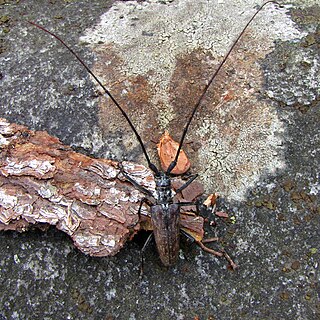Palaeopteryx is an extinct genus of dubious paravian theropod dinosaur from the Morrison Formation of Colorado. The type species is P. thomsoni.

Monochamus is a genus of longhorn beetles found throughout the world. They are commonly known as sawyer beetles or sawyers, as their larvae bore into dead or dying trees, especially conifers such as pines. They are the type genus of the Monochamini, a tribe in the huge long-horned beetle subfamily Lamiinae, but typically included in the Lamiini today.

Marshall's horseshoe bat is a species of bat in the family Rhinolophidae. It is found in Laos, Malaysia, Thailand, and Vietnam.
Limnotrochus is a monotypic genus in the family Paludomidae containing the single species Limnotrochus thomsoni, a tropical freshwater snail with gills and an operculum, aquatic gastropod mollusk. It is endemic to Lake Tanganyika.

Aeneator is a genus of sea snails, marine gastropod molluscs in the whelk family Tudiclidae.
The McKay Formation is a geologic formation in Oregon. It preserves fossils dating back to the Tortonian to Zanclean stages (Hemphillian) of the Neogene period.

Monochamus dubius is a species of beetle in the family Cerambycidae. It was described by Charles Joseph Gahan in 1894. It is known from India, Thailand, Myanmar, Vietnam, Taiwan, and China.
Monochamus adamitus is a species of beetle in the family Cerambycidae. It was described by James Thomson in 1857. It is known from Tanzania, Sierra Leone, Angola, Ghana, Mozambique, the Ivory Coast, Senegal, the Democratic Republic of the Congo, Malawi, and Zimbabwe.

Monochamus sutor is a species of beetle in the family Cerambycidae. It was described by Carl Linnaeus in 1758, originally under the genus Cerambyx. It has a wide, natural distribution throughout Europe, and has also been introduced into Belgium and the Netherlands. Adults measure between 15 and 24 mm, and larvae measure up to 45 mm (1.8 in).

Monochamus alternatus, the Japanese pine sawyer, is a species of beetle in the family Cerambycidae. It was described by Frederick William Hope in 1842. It is known from Hong Kong, Vietnam, Laos, North Korea, South Korea, Japan, China, and Taiwan. It feeds on Pinus banksiana, Abies firma, Pinus armandii, Pinus massoniana, Pinus yunnanensis, and Pinus densiflora. It serves as a vector for the nematode Bursaphelenchus xylophilus.

Monochamus clamator, the spotted pine sawyer, is a species of beetle in the family Cerambycidae. It was described by John Lawrence LeConte in 1852.

Monochamus galloprovincialis, the pine sawyer beetle, also referred to as the black pine sawyer beetle, is a species of beetle in the family Cerambycidae. It was described by Olivier in 1795, originally under the genus Cerambyx. It has a wide distribution, occurring naturally throughout Europe and the Caucasus. It has also been introduced into the Canary Islands. It serves as a vector for the parasitic nematode species Bursaphelenchus xylophilus, and also acts as a host to the parasitoid wasp species Dolichomitus tuberculatus.

Monochamus maculosus, the spotted pine sawyer, is a species of beetle in the family Cerambycidae. It is known from Canada and the United States, and was formerly known as Monochamus mutator.

Monochamus notatus, the northeastern pine sawyer or notable sawyer, is a species of beetle in the family Cerambycidae. It was described by Dru Drury in 1773, originally under the genus Cerambyx. It is known from Canada and the United States.

Monochamus ruspator is a species of beetle in the family Cerambycidae. It was described by Johan Christian Fabricius in 1781, originally under the genus Lamia. It has a wide distribution throughout Africa, and is also present in Kazakhstan.

Monochamus sartor is a species of beetle in the family Cerambycidae. It was first described by Johan Christian Fabricius in 1787, under the genus Lamia. It is known from throughout Europe, as well as in Kazakhstan, Mongolia, North Korea and South Korea. It is rated by the IUCN as Least Concern.

Poimenesperus thomsoni is a species of beetle in the family Cerambycidae. It was described by Francis Polkinghorne Pascoe in 1869. It is known from the Democratic Republic of the Congo, Gabon, Cameroon, and Equatorial Guinea. It feeds on Xylopia aethiopica.
Spotted pine sawyer is a common name for several insects and may refer to:

Profenusa thomsoni, the amber-marked birch leaf miner, is a species of sawfly in the family Tenthredinidae. It is native to the Palearctic realm but has spread to North America. The larvae feed on the foliage of birch trees.
Alligator thomsoni is an extinct species of alligator that existed during the Early Miocene period. Their range was principally in what is now known as Nebraska, United States.













